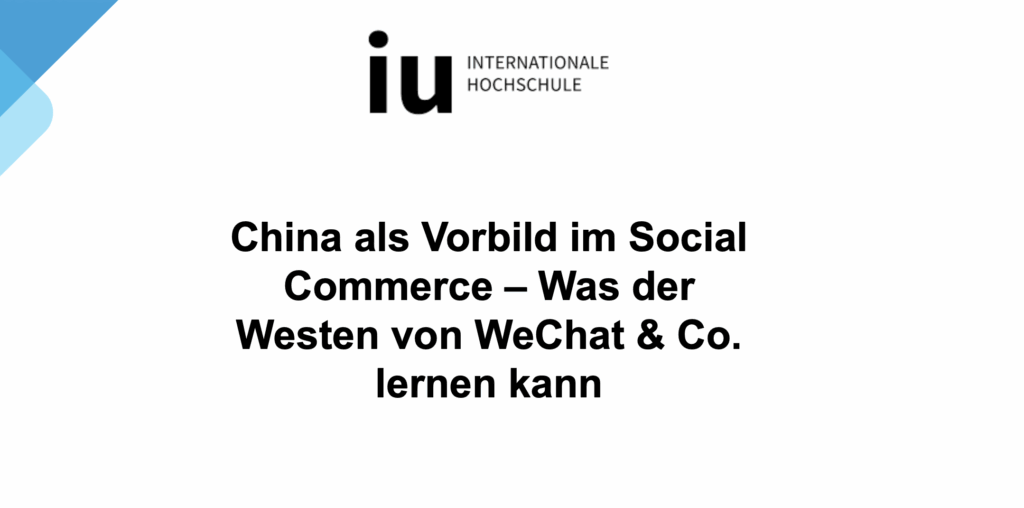China has become the global innovation engine of social commerce. Platforms like WeChat, Douyin (TikTok China) and Taobao Live have already demonstrated how seamlessly social interaction, entertainment and in-app shopping can merge into one ecosystem. In Europe, by contrast, social commerce is still at an early stage—fragmented, highly regulated and culturally more cautious.
The presentation “China and Social Commerce – What the West Can Learn from WeChat & Co.” provides a structured analysis of the key factors driving China’s success and reveals how European companies can benefit from these insights without compromising their own values.
What Social Commerce Really Is
According to Shopify, social commerce combines three core dimensions:
-
Technological: in-app shopping, livestreams, payments, AR/VR
-
Social: likes, comments, sharing, communities
-
Psychological: trust, peer influence, social proof
-
Two research frameworks explain why it works so well:
-
Trust Transfer Theory: trust in influencers transfers to products and brands.
-
Technology Acceptance Model (TAM): users adopt technologies they perceive as useful and easy to use.
Market Potential: China vs. Europe
China generates 497 billion USD in social-commerce revenue—representing the majority of the global 764 billion USDmarket.
Europe, on the other hand, shows slower adoption due to:
-
stricter privacy regulations (GDPR)
-
limited payment integration
-
cultural unfamiliarity with livestream selling
-
a stronger focus on entertainment rather than shopping
As a result, social media in Europe is primarily used for inspiration and entertainment—not conversion.
Why Social Commerce Thrives in China
The presentation identifies four main success drivers:
1. Super-App Integration
In China, everything happens within one app: feed → product → payment → delivery.
WeChat functions simultaneously as messenger, shop, bank, service center and social network.
2. A Culture of Digital Interaction
Users are highly engaged through comments, ratings, virtual gifts and live interactions—shopping is social, not just transactional.
3. Regulatory Support for Local Platforms
Domestic platforms benefit from a regulatory environment that encourages local ecosystem growth.
4. Early Investments
Livestream shopping, creator commerce and frictionless payment solutions have been deeply integrated for years.
Why Europe Is Falling Behind
Key barriers outlined in the presentation include:
-
GDPR-driven privacy restrictions
-
Limited payment and logistics integration
-
Cultural reservation toward live selling
-
Less established creator-commerce structures
This results in platforms being used more for viewing and entertainment, not seamless shopping.
What Europe Can Learn From China
The presentation highlights four clear strategic recommendations:
1. Seamless Feed-to-Checkout Journeys
Friction must be reduced.
TikTok Shop is an early example, but deeper integration is needed across platforms.
2. Turn Creators Into Brand Ambassadors
Instead of short campaigns:
-
cultivate long-term partnerships
-
rely on micro- and niche-influencers
-
give creators more creative freedom
3. Use Livestream Shopping Strategically
Douyin demonstrates how livestreaming can merge entertainment and sales.
Success factors include:
-
storytelling and product education
-
creator credibility
-
exclusive time-limited discounts
-
direct in-app purchasing
4. Build Trust Without Losing Control
Europe should adapt China’s strengths—but not copy them.
Important:
-
maintain strict privacy standards
-
remain transparent
-
ensure authentic creator content
Conclusion
China is a pioneer—but not a one-to-one model for Europe.
The potential for social commerce in Europe is significant, but adoption will be slower, more regulated and value-driven.
Companies that invest now in platform innovation, creator integration and livestream-shopping pilots will shape the next era of European e-commerce.
About the Author
This article is based on the presentation “China and Social Commerce – What the West Can Learn from WeChat & Co.”, created by Ludwig Goosen (iU International University) as part of a project supervised by Prof. Dr. Richard Geibel.
